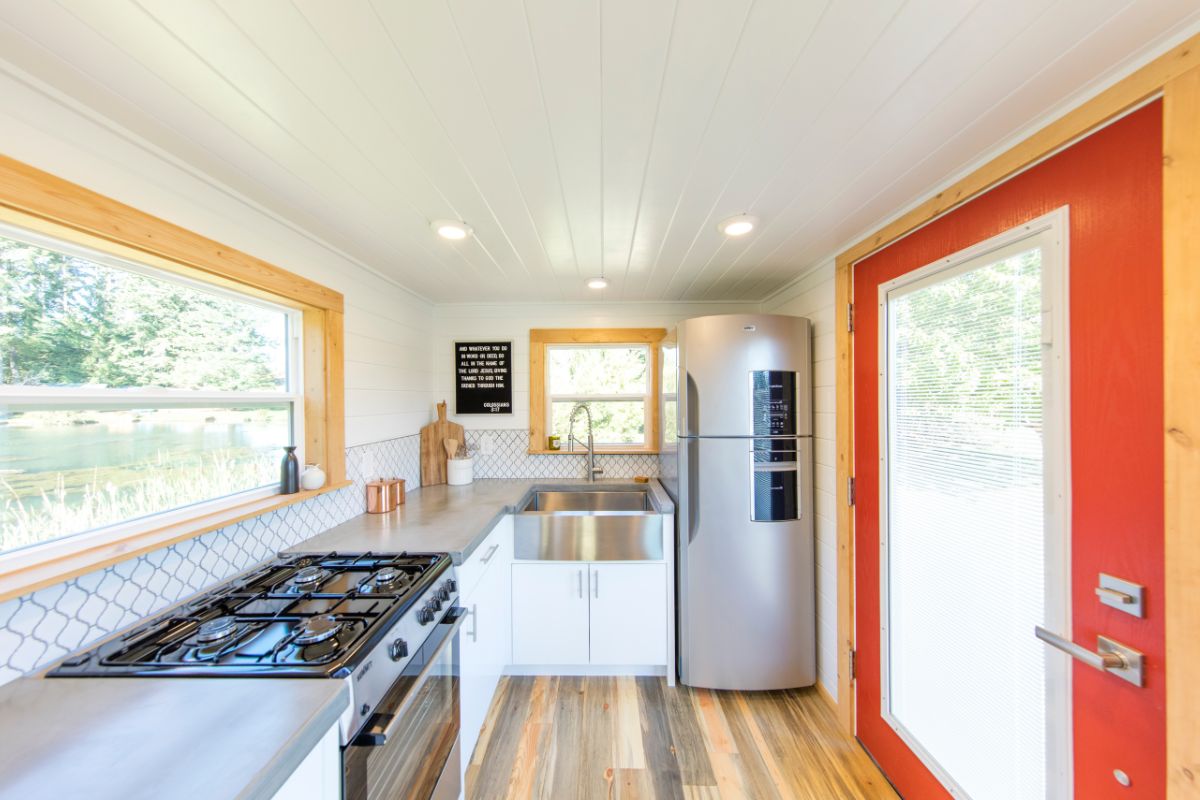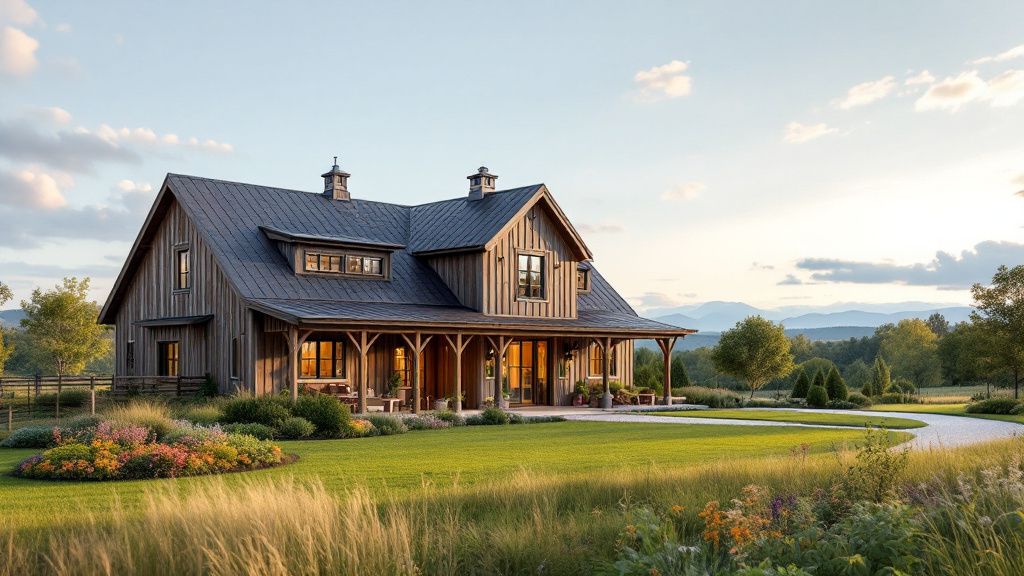Building your tiny house effectively starts with selecting durable framing materials like steel or engineered wood. Insulate with high-performance materials to maximize energy efficiency and keep utility bills low.
Opt for metal roofing for longevity and effective drainage. Balance aesthetics and durability with your choice of siding. Embrace renewable energy solutions to power your home sustainably. Efficient plumbing systems and eco-friendly choices further enhance functionality. There's more to explore for creating a compact and sustainable haven.
Key Takeaways
- Prioritize sustainable materials like reclaimed wood and bamboo to minimize environmental impact and enhance durability.
- Implement high-performance insulation such as spray foam to maximize energy efficiency and reduce heating and cooling costs.
- Install solar panels to leverage renewable energy, reducing reliance on non-renewable resources and achieving energy independence.
- Opt for efficient water management solutions like low-flow faucets and rainwater harvesting systems to conserve water.
- Use passive design principles to maximize natural light and ventilation, reducing the need for artificial lighting and air conditioning.
Framing: Choosing the Right Materials
When it comes to framing your tiny house, selecting the right materials is essential for ensuring durability and structural integrity. You should consider several factors like weight, cost, and environmental impact.
Wood is a popular choice due to its affordability and ease of use. However, it can be prone to moisture-related issues unless properly treated. Steel offers strength and resistance to pests and rot, albeit at a higher cost and added weight. Engineered wood products like LVL and CLT provide a balance of strength and sustainability but require careful planning and expertise.
Each option has distinct advantages and trade-offs, so it's vital to assess your specific needs and priorities. Choose materials that align with your design and budget constraints.
Insulation: Maximizing Energy Efficiency
Although building a tiny house comes with unique challenges, prioritizing energy efficiency through effective insulation can greatly enhance comfort and reduce utility costs.
Start by selecting high-performance materials like spray foam or rigid foam boards, known for their superior thermal resistance and air-sealing capabilities. These materials help maintain consistent indoor temperatures, no matter the season.

Don't overlook the importance of properly insulating all areas, including walls, floors, and ceilings. Pay attention to R-values, which measure thermal resistance—higher values mean better efficiency.
Consider using recycled or sustainable materials for an eco-friendly approach. Avoid gaps in insulation that can lead to heat loss or gain. By focusing on insulation, you'll create a cozy, energy-efficient space that minimizes environmental impact and maximizes savings.
Roofing: Weatherproofing Your Tiny Home
Ensuring your tiny home is weatherproof begins with choosing the right roofing materials and techniques. Opt for metal roofing, a durable and lightweight option that excels in shedding rain and snow. It's also resistant to wind damage. Consider a steep pitch to promote efficient drainage and prevent leaks.
For additional protection, install a high-quality underlayment to act as a moisture barrier. Pay attention to flashing around vents and skylights to prevent water ingress. Seamless gutters are essential; they direct water away from your foundation, reducing the risk of moisture damage.
Regular maintenance, including clearing debris and checking for damage, is vital. These strategies not only protect your tiny home from the elements but also extend the lifespan of your roof.
Siding: Balancing Aesthetics and Durability
Choosing the right siding for your tiny house involves a careful balance between aesthetics and durability. You want it to look appealing while standing up to the elements. Start by considering materials like wood, metal, vinyl, and fiber cement. Wood offers a classic look but requires more maintenance.
Metal siding is durable and low-maintenance but can be noisy during rain. Vinyl is affordable and comes in various styles, but it may not withstand extreme weather well. Fiber cement is durable and offers a range of design options, though it's heavier and pricier. Evaluate your climate and budget to decide what best suits your needs. Remember, the right siding not only enhances your home's appearance but also protects it effectively.

Flooring: Creating a Comfortable Foundation
How do you create a comfortable and durable foundation for your tiny house? Start by choosing the right flooring material. Consider engineered wood for its resilience and aesthetic appeal. It's less prone to warping compared to solid wood, making it ideal for small spaces.
Vinyl flooring is another excellent option; it's waterproof, affordable, and comes in various styles that mimic natural materials. If you prefer something eco-friendly, opt for bamboo or cork, both sustainable and comfortable underfoot.
Installation is essential. Guarantee a proper subfloor, typically plywood, to provide stability. Use underlayment to enhance insulation and soundproofing.
Pay attention to moisture barriers, especially if your tiny house is on wheels. By combining the right materials and techniques, you'll create a floor that's both practical and inviting.
Windows and Doors: Enhancing Natural Light and Ventilation
Why are windows and doors so important in a tiny house? They maximize natural light and improve ventilation, making your compact space feel larger and more comfortable. Choosing the right windows is significant.
Opt for strategically placed, energy-efficient windows to reduce reliance on artificial lighting and enhance airflow. Casement or awning windows can be excellent for ventilation, as they open fully.
For doors, consider sliding or folding styles to save space. A glass door can double as a window, letting in additional light. It's critical to guarantee proper sealing to maintain temperature control and avoid drafts.
Also, consider the orientation of your tiny house to capture natural light and breezes effectively. Prioritizing these elements will create a brighter, healthier living environment.
Plumbing: Efficient Water Management
When planning the plumbing for your tiny house, efficient water management is critical to maximizing both functionality and sustainability. Start by installing low-flow faucets and showerheads to conserve water without sacrificing performance.
Consider a tankless water heater for instant hot water and reduced energy consumption. Use PEX piping for its flexibility and resistance to freezing, making it ideal for tight spaces. Install a water filtration system to guarantee clean, safe drinking water, especially if you rely on rainwater collection.
Opt for a composting toilet to minimize water waste and reduce your environmental footprint. Finally, design your plumbing layout to minimize pipe lengths and bends, which will improve water pressure and reduce the risk of leaks. Prioritize these strategies for a sustainable system.
Electrical Systems: Safe and Sustainable Solutions
Just as efficient plumbing is essential for sustainability, a well-planned electrical system guarantees safety and energy efficiency in your tiny house.
First, determine your power needs and consider renewable energy sources like solar panels to minimize your carbon footprint. Select energy-efficient appliances and LED lighting to reduce consumption.
Use a circuit breaker panel to safeguard against electrical overloads and install GFCI outlets in moisture-prone areas like kitchens and bathrooms.
Ensure all wiring adheres to local codes and regulations for safety. Consult with a certified electrician when planning and installing your system to avoid potential hazards. Consider using smart technology to monitor and control energy usage remotely. A thoughtfully designed electrical system enhances both your tiny house's functionality and sustainability.
Interior Design: Optimizing Space and Functionality
Though tiny houses come with limited space, thoughtful interior design can maximize both functionality and comfort. Start by incorporating multi-purpose furniture, like a sofa bed or a foldable dining table, to save space and add versatility. Utilize vertical space by installing shelves, hanging organizers, or loft beds. This approach frees up floor area, making the room feel larger.

Choose a light color palette to create an airy atmosphere and use mirrors strategically to reflect natural light, enhancing the perception of space. Consider built-in storage solutions, such as under-stair drawers or hidden compartments, to keep the living area tidy. Prioritize open floor plans to maintain flow and guarantee each element serves a purpose. Thoughtful design choices transform small spaces into functional homes.
Eco-Friendly Options: Reducing Your Environmental Impact
Building a tiny house with eco-friendly methods not only reduces your environmental footprint but also enhances sustainability. Start by selecting sustainable materials like reclaimed wood or bamboo, which offer durability and low impact.
Insulate efficiently with natural fibers such as wool or cotton to minimize energy consumption. Install solar panels to harness renewable energy and reduce reliance on non-renewable resources. Opt for water-saving fixtures, like low-flow faucets and composting toilets, to conserve water effectively.
Consider passive design principles: position your house to maximize natural light and ventilation, reducing the need for artificial lighting and air conditioning. Use non-toxic paints and finishes to improve indoor air quality. By integrating these eco-friendly choices, you're not just building a home; you're crafting a sustainable lifestyle.
Conclusion
Building your tiny house requires thoughtful decisions in every aspect. Choose materials for framing that guarantee durability, and maximize energy efficiency with proper insulation. Weatherproof your home with reliable roofing, and find siding that balances looks with longevity.
Opt for flooring that adds comfort, and incorporate efficient plumbing and safe electrical systems. Prioritize space optimization in your interior design. By considering eco-friendly options, you'll not only reduce your environmental impact but also create a sustainable, cozy haven.






Share: